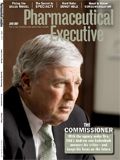Direct to Consumer: A Dream Campaign
With their memorable characters, sense of humor, and ability to balance creative with clinical information, the Rozerem ads have broken the traditional pharma ad template
Takeda's surreal ad campaign for the sleep aid Rozerem (ramelteon) has stirred up more controversy and intrigue than any DTC ad in recent memory. With its unforgettable characters, sense of humor, and ability to balance creative with clinical information, the ads have broken the traditional pharma advertising template. But most important, people are talking about the commercial with the beaver.

George Koroneos
Watch almost any prime-time television show and you're bound to come across the ad. It features a conversation between an insomniac and his dreams about his lack of sleep. The tagline Your dreams miss you scrolls across the bottom of the screen as Abe Lincoln and a beaver chat with the patient over a game of chess. Print ads show the duo in similar situations, and the brand's Web site offers interactive features, videos, and health information. Takeda has even gone as far as branding the icons on subway cars, in elevators, and—best yet—on coffee mugs.
Does the campaign sound too over-the-top for a sleep aid? Perhaps, but Takeda is facing off against two blockbuster sleep drugs—Ambien (zolpidem) and Lunesta (eszopiclone)—in a very crowded insomnia market.
Even worse, FDA approved Rozerem in July 2005, but Takeda postponed consumer advertising due to an industry-imposed, one-year DTC moratorium.
Takeda spent 2005 to 2006 bulking up its professional campaign with AbelsonTaylor at the helm. The ad team highlighted the drug's unique method of action (MOA)—a selective melatonin receptor agonist that lacks the addictive quality of competing sleep aids. "We wanted to give our sales representatives time to meet with healthcare professionals and educate them on the importance of treating insomnia and how Rozerem works," explains Chris Benecchi, product director for Rozerem marketing. "We wanted them well versed in how to prescribe it long before we ever started the consumer campaign."
Creating A Concept
For the DTC campaign, Takeda continued working with AbelsonTaylor (which was new to the DTC space) and added consumer-advertising powerhouse Cramer-Krasselt to the team. "At the time, we were growing into our consumer franchise," explains Stephen Neale, vice president, creative director at AbelsonTaylor. "I think Takeda wanted the best of both worlds—an experienced consumer agency in CK and an agency that understands the FDA regulations in AbelsonTaylor."
The concept of the beaver and Abe Lincoln was conceived through conversations with groups of consumers about what they expect from a DTC ad. The breakthrough moment was when the three teams started hearing consumers say that they miss being able to dream.
"With this campaign, we shift the paradigm in the category from showing people sleeping to showing people not sleeping—if you can't sleep, you can't dream, and your dreams miss you," says Ken Erke, vice president group creative director at Cramer-Krasselt.
But why a beaver? "This campaign isn't about a beaver or Abe, it's about an individual that can't sleep because of the daily pressures in his life," Neale says. "This ad is the chance for the patient's dreams to sit down with him and tell him that there is a product that can get him back into the dream world."
The Abraham Lincoln concept received an extraordinary response when it was tested. "We get a lot of people calling to say they love the commercial, but also asking us to explain all the subtle nuances about the characters," Benecchi says. "If they are willing to watch an ad that many times, it's giving the message an opportunity to seed with the public."
The Push for Sales
Grabbing people's attention with an innovative ad is one thing, but what about moving units? The estimated $100 million DTC campaign cost more than Rozerem earned in sales in 2006. This year, it stands to make a profit, but nowhere near what the competition is bringing in.
Although Rozerem has been slow to recoup ad costs, Benecchi says that drug sales are on the rise as the campaign rolls on. Last year, the drug had $76.2 million in sales, up from $13.3 million in 2005 (July through December), according to IMS Health. For the first quarter of 2007, the drug has earned $28.1 million, outpacing Sonata in the total sleep aid category, but far below what Lunesta ($181 million) or Ambien ($653 million) brought in during the same time period.
"The ad is causing a ton of buzz but very little sales," explains Pharma Marketing News editor John Mack. Mack thinks the company should have spent more time and money informing consumers of the drug's MOA and the fact that it is a nonaddictive sleep aid. "I've been waiting for the next phase of this campaign for a long time, but so far all I see is Abe and a beaver," Mack says. "While the company is doing a slow buildup, the sales are doing a slow burn."
Benecchi claims that the slow build was the plan all along. The first television spot was intended to be thought provoking without drawing focus to the product. "It wasn't an ad that gave consumers all of the messaging at once," Benecchi says. "We wanted to draw them in with this ad, get them invested in the characters, and make them curious." The television spot stirred up some buzz, but it also got people questioning Takeda's strategy.
"I've never heard of such a thing in pharmaceutical marketing," Mack says. "Usually, a drug has a very short life span to break into the market, considering they have a limited patent life and very heavy competition."
Since the first spot premiered, Takeda has compounded its messaging with each consecutive ad. "We've seen a remarkable jump in brand awareness and brand linkage—characters, tagline, concept—all to Rozerem's name," Benecchi says. "It's really grown organically over the course of the last year."
Success Through Integration
In the last year, the Rozerem campaign has become a case study in how to make an attention-grabbing DTC ad. According to Phillip Sawyer of Starch Communications, a custom-research company that gauges the stopping power of DTC ads, readership of the Rozerem print campaign is "stratospheric."
"Readers really got involved with the print ads once they were familiar with the television campaign," Sawyer says. "My belief is that if the TV campaign had not gone out, the print ads wouldn't have done anywhere near as well."
On a scale with an average score of 100, the most recent Rozerem print spot scored above average in "noted" (103), "associated" (102), "read some" (108), and "read most" (135). By way of comparison, the first ad of the campaign scored low: "noted" (84), "associated" (72), "read some" (58), "read most" (71). "This campaign took a while to get a hold, but once the television ad became established, the print started to work with it," says Sawyer. "This is a perfect example of the synergistic effect of TV and print ads working together."
Fun or Funny?
Many in the industry don't like the ad because they feel that humor doesn't have a place in pharma. During the recent DTC Perspectives conference in Washington, DC, marketers liberally made snide (but mostly off-the-record) comments about the campaign. Is this just a case of beaver envy?
"Prescription medication is a serious business," says Mel Sokotch, author of Shortcuts to the Obvious. "We are talking about drugs that have serious side effects, and they should be treated with respect. Abe and a muskrat are not in line with what this industry is about."
MSCO chief Mark Stevens disagrees, stating that the Rozerem campaign succeeds in breaking the model of what a pharma ad should be. "I think the commercial is memorable, unusual, and I certainly remember it," says Stevens, who penned the book Your Marketing Sucks. "I like the fact that they are having fun with a serious topic, but not being funny. If you can go down a path that makes people scratch their heads at first but eventually get it, then you've made a good commercial."
MOVES Blue Diesel opened an office in Newtown, Penn.
PEOPLE TMX Communications named Debra Brown president. // AbelsonTaylor hired Eric Densmore as senior account supervisor and Dan Lathitham as account supervisor. // Core-Create appointed Sam Lowe creative director, copy. // Digitas Health promoted Len Dolce to senior vice president, general manager.

Sam Lowe
George Koroneos is associate editor at Pharmaceutical Executive. He can be reached at gkoroneos@advanstar.com

The Misinformation Maze: Navigating Public Health in the Digital Age
March 11th 2025Jennifer Butler, chief commercial officer of Pleio, discusses misinformation's threat to public health, where patients are turning for trustworthy health information, the industry's pivot to peer-to-patient strategies to educate patients, and more.
Navigating Distrust: Pharma in the Age of Social Media
February 18th 2025Ian Baer, Founder and CEO of Sooth, discusses how the growing distrust in social media will impact industry marketing strategies and the relationships between pharmaceutical companies and the patients they aim to serve. He also explains dark social, how to combat misinformation, closing the trust gap, and more.